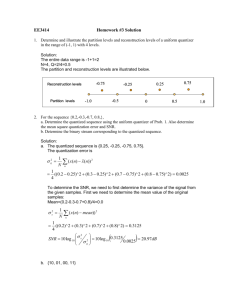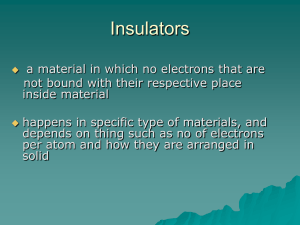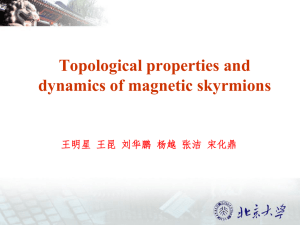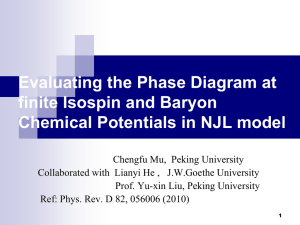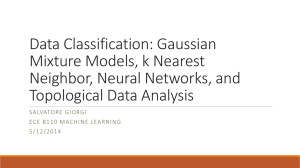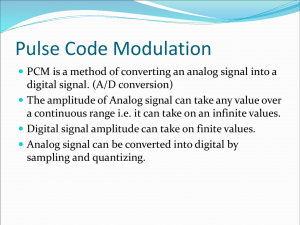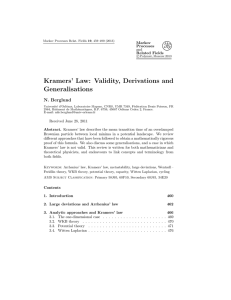Topological Numbers and Their Physical Manifestations
advertisement
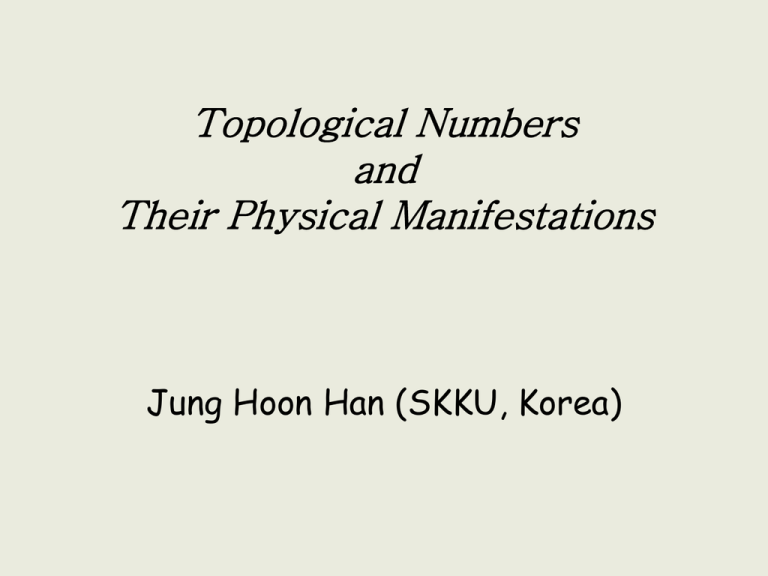
Topological Numbers and Their Physical Manifestations Jung Hoon Han (SKKU, Korea) “Topological Numbers” Numbers one can measure that do not depend on sample, level of purity, or any kind of details as long as they are minor Examples of Topological Numbers Quantized circulation in superfluid helium Quantized flux in superconductor Chern number for quantized Hall conductance Skyrmion number for anomalous Hall effect Z2 number for 3D topological insulators Each TN has been worth a NP Condensates and U(1) Phase Quantized circulation in superfluid helium Quantized flux in superconductor Despite being many-particle state, superfluid and superconductor are described by a “wave function” Y(r) eif(r) Y(r) =| Y(r)| is single-valued, and has amplitude and phase Singularity must be present for nonzero winding number Singularity means vanishing | Y(r)|, or normal core Wavefunction around a Singularity Near a singularity one can approximate wavefunction by its Taylor expansion Employing radial coordinates, b/a is a complex number, for simplicity choose b/a=1 Indeed a phase winding of 2p occurs “Filling in” of DOS as vortex core is approached “flux quantization” Singularity in real space Flux/circulation quantization are manifestations of real-space singularities of the complex (scalar) order parameter Quantized Hall Conductance in 2DEG Discovery of IQHE by Klitzing in 1980 2D electron gas (2DEG) Hall resistance a rational fraction of h/e2 Hall Conductance from Linear Response Theory Kubo formulated a general linear response theory Longitudinal and transverse conductivities as current-current correlation function Works for metals, insulators, whatever Hall Conductance for Insulators Thouless, Kohmoto, Nightingale, den Nijs (TKNN) considered band insulator with an energy gap formulated a general linear response theory TKNN formula works for any 2D band insulator TKNN on the Go Integral over 2D BZ of Bloch eigenfunction yn(k) for periodic lattice Define a “connection” Using Stokes’, bulk integral becomes line integral As with the circulation, this number is an integer sxy is this integer (times e2/h) Singularity in real vs. momentum space Topological Object Space Physical Manifestation U(1) vortex R Flux quantization in 2D SC Circulation quantization in 2D SF U(1) vortex K QHE in 2DEG under B-field Magnetic field induces QHE by creating singularities in the Bloch wave function In both, relevant variable is a complex scalar Haldane’s Twist Haldane devised a model with quantized Hall conductance without external B-field (PRL, 88) His model breaks T-symmetry, but without B-field which topological invariant is related to sxy ? A graphene model with real NN, complex NNN hopping Skyrmion Number in Momentum Space By studying graphene, Haldane doubles the wave function size to two components (Dirac Hamiltonian in 2D momentum space) Hall conductance of H can be derived as an integral over BZ “Skyrmion number” QAHE & QSHE If two-component electronic system carries nonzero Skyrmion number in momentum space, you get QHE effect without magnetic field (QAHE) If sublattice as well as spin are involved (4-component), you might get QSHE (Kane&Mele, PRL 05) Momentum vs. Real-space Skyrmions Momentum-space Real-space Quantized Hall response in two-component electronic systems Anomalous Hall effect by coupling to conduction electrons Looks like Physical Role Presence of Gapless Edge States Gapless edge states occur at the 1D boundary of these models (charge and/or spin transport) “QSHI” Kramers pair Kramers pairs not mixed by T-invariant perturbations BULK Zero charge current Quantized spin current Kramers pair BULK “QAHI” Partner change due to large perturbation BULK Zero spin current BULK Quantized charge current Zero magnetic field “BI” Partner change due to large perturbation BULK Zero spin current Zero charge current Counterpropagating edge modes mix BULK ALL discussions were limited to 2D 2D quantized flux 2D flux lattice 2D quantized Hall effect 2D quantized anomalous Hall effect 2D quantized spin Hall effect Extension of topological ideas to 3D has been a long dream of theorists Z2 Story of Kane, Mele, Fu (2005-2007) For generic SO-coupled systems, spin is not a good quantum number, then is there any meaning to “quantized spin transport”? Kane&Mele came up with Z2 concept for arbitrary SO-coupled 2D system The concept proved applicable to 3D Z2 number was shown to be related to parity of eigenfunctions in inversion-symmetric insulators -> Explosion of activity on TI Surface States of Band Insulator Take a band insulator in 2D or 3D Introduce a boundary condition (surface), and as a result, some midgap states appear CB Ly Lx kz ky VB kx (Lx, Ly) TRIMs and Kramers Pairs Band Hamiltonian in Fourier space H(k) is related by TimeReversal (TR) operation to H(-k) Q H(k) Q-1 = H(-k) IIf k is half the reciprical lattice vector G, k=G/2, Q H(G/2) Q-1 = H(-G/2) = H(+G/2) These are special k-vectors in BZ called TimeReversalInvariantMomenta (TRIM) TRIMs and Kramers Pairs At these special k-points, ka, H(ka) commutes with Q By Kramers’ theorem all eigenstates of H(ka) are pairwise degenerate, i.e. H(ka) |y(ka)> = E(ka) |y(ka)>, H(ka) (Q |y(ka)>) = E(ka) (Q |y(ka)>) To Switch Partners or Not to Switch Partners (Either-Or, Z2 question) (Lx, 1 Ly ) Charlie and Mary gets a divorce. A year later, they re-marry. (Boring!) k k2 k 1 k2 (Lx, Ly ) Charlie and Mary gets a divorce. A year later, Charlie marries Jane, Mary marries Chris. (Interesting!) Protection of Gapless Surface States EF (Lx, 1 Lx ) No guarantee of surface states crossing Fermi level k k2 k 1 k2 (Lx, Lx ) Guarantee of surface states This is the TBI Kane-Mele-Fu Proposal : Kramers partner switching is a way to guarantee existence of gapless edge (surface) states of bulk insulators 4 TRIMs in 2D bands Each TRIM carries a number, da =+1 or -1 Projection to a given surface (boundary) results in surface TRIMs, and surface Z2 numbers pi d4 d1 d2 p2=d3d4 kx p1=d1d 2 Band Insulator d3 Gapless Edge? ky If the product of a pair of pi numbers is -1, the given pair of TRIMs show partner-switching -> gapless states In 2D, p1p2=d1d2d3d4 Z2 number n0 defined from (1)n0=d1kd d3d4 y 2 d3 d1 d4 d2 p2=d3d4 kx p1=d1d 2 p1p2= -1 In 3D, projection to a particular surface gives four surface numbers p1, p2, p3 , p4 d8 d7 d5 p4= d7d p3=d5d6 d6 8 d3 d4 d1 d2 p2=d3d4 p1=d1d2 p1p2 p3 p4 p =-1 p p = d d d d p 1 2 3 4 1 2 3 4 d5d6 d7 d8=-1 Gaplessdsurface state ondevery surface 8 7 1 d6 Strong TI d3 -1 d4 d1 d2 Dirac Circle d5 -1 -1 So What is d ? For inversion-symmetric insulator, d is a product of the parity numbers of all the occupied eigenstates at a given TRIM For general insulators, d is the ratio of the square root of the determinant of some matrix divided by its Pfaffian Summary Topological Object Space Physical Manifestation U(1) vortex R Flux quantization in 2D SF Circulation quantization in 2D SF U(1) vortex K QHE in 2DEG under B-field Skyrmion R AHE in 2D metallic magnet AHE of magnons Skyrmion K AHE, QSHE in 2D band insulator Z2 K 2D&3D TBI

